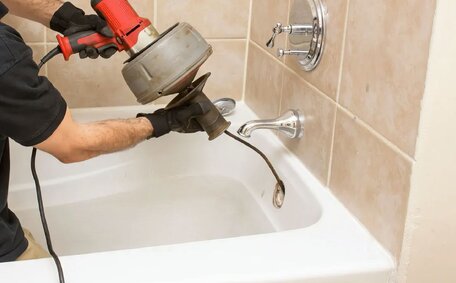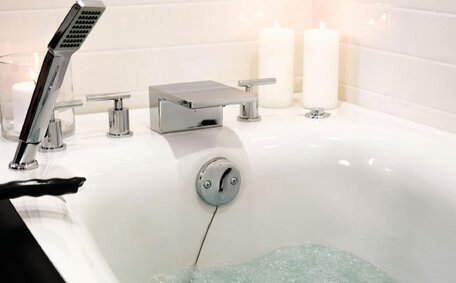Introduction to Common Household Plumbing Issues
Homeowners frequently face common plumbing challenges such as clogged drains, leaking taps, and defective water heaters. It’s important to address these common issues quickly before they lead to more severe problems or expensive repairs down the line.
This guide offers practical troubleshooting advice for resolving typical household plumbing issues on your own. We’ll explore the causes behind low water pressure, running toilets, and sluggish sinks. By understanding what causes these issues and when it’s time to call in the pros, you’ll be well-equipped to take action.
Equipped with these tips, respond promptly to early signs of plumbing issues, like unexplained water flow, to manage your system effectively. Prompt action is crucial to manage water flow, prevent flooding, mitigate leak damage, and avoid future appliance or pipe repairs.
Performing Quick At-Home Troubleshooting
When toilet malfunctions occur at home, there are several quick troubleshooting steps you can take to diagnose and resolve common problems. Here’s a quick rundown of useful tips for your initial home checks:
Check Water Pressure
Low water pressure in your house could signify dilemmas such as clogged pipes, suboptimal water heaters, or complications with the municipal water supply. Consider these steps to evaluate water pressure:
- Run water through the system and find out if the flow water from your faucets matches the expected efficiency. Pressure readings should be between 310-551 kPa.
- Ensure all your taps are completely turned off and verify the pressure gauge on your main water line for an accurate reading.
- Flush your toilet to clear the overflow tube, run multiple taps, and retest – you’ll need to check if water level from your water tank maintains water pressure under heavy usage.
Assess Visible Signs of Leaks
Carefully inspect your plumbing system to locate and address leaking pipes promptly. Warning signs include:
- Noticeable damp areas or accumulated water by your hot water heater, under sink faucet, or near toilets signify complications.
- Dripping sink faucets, showerheads, or other water outlets can escalate into more significant issues.
- Rust spots or cracks on pipes.
Act swiftly when you discover bathroom pipe leaks to avoid water damage, and if uncertain, consider the following steps:
Evaluate Noises in Pipes
Strange gurgling, clanking, or loud hammering sounds from a vent pipe could signify issues like:
- Air trapped in pipes - Drain sinks and flush toilets to release built-up air pressure. Consider investing in an air vacuum breaker.
- Mineral buildup - Flush out pipes and consider water softening solutions, which can also reduce future clogs.
- Loose fixtures - Inspect for loose or damaged parts on valves, showerheads, supply tubes.
Ensure your water valves are turned off before inspecting fixtures. Always wear eye protection while inspecting sinks or drains for problems.
Clearing Clogged Drains
A clogged shower drain is among the most frustrating issues that can disrupt your shower experience. Pungent odours may signal a congested drain where water begins to drain slowly, accompanied by gurgling sounds, and pooling water.
Trying a Plunger
Begin by trying to dislodge clogs with a plunger. Firmly place the plunger over the drain and vigorously plunge 10-15 times to break up the blockage. You may need to repeat a few times and try both sink and overflow plate positions.
Using Baking Soda and Vinegar
For sinks, mix 1⁄2 cup of baking soda with 1⁄2 cup of white vinegar to counteract soap scum and pour it down the drain forcefully. Seal the drain snugly for 5-10 minutes before you pour down boiling water to rinse off the disintegrated dirt. This dynamic chemical reaction efficiently melts away blockages including hair soap tangles, oils, and grease.
Snaking the Pipe
If DIY methods fail to clear the blockage, try using a plumber’s snake, available for rent or purchase at hardware stores. Feed the flexible cable into the drain, cranking handles to navigate through bends. By turning the snake’s handle, you’ll fragment and capture other debris, facilitating its removal upon retraction.
For drainage system issues beyond your reach, consider professional help or adopt prevention strategies to prevent future complications. Resist using caustic chemical drain cleaners - they can damage pipes.
Fixing Toilet Tank Problems
Toilet tanks contain several components whose malfunctioning can cause continuous water flow or incomplete flushing. Here are some common toilet tank troubles and solutions:
Running Toilet
If your toilet runs continuously, even when not in use, it’s typically a problem with the fill valve or flush valve:
- Adjust the toilet float height: The float ball governs the water level, managing the water entry into the tank, which, if set too high, can usually cause unwarranted overflow. Carefully bend the float rod to lower the ball by approximately 1 cm.
- Clean or replace flapper valve: An ineffective rubber flapper seal can let water incessantly seep into the toilet bowl. Attempt cleaning away the mineral deposits that are no longer off the valve seat into the toilet. If worn, replace the entire flapper valve assembly.
Weak Flush
A weak or incomplete flush, which suggests a flush toilet malfunction, often results from issues within the tank’s flushing mechanisms:
- Adjust the chain connecting the flapper valve to ensure it’s not too slack or taut, which can disrupt the siphon effect. Set it to provide about 2.5 cm of slack, which can resolve slow flushing issues.
- Clear obstructions under rim: Inspect and clean out any obstructions clogging the small openings beneath the toilet rim. Clogs here can cause a slow drain, reducing crucial syphon-jet action.
For persistent toilet issues, call professional plumbers to scrutinise the entire tank and discern issues to restore proper function.
Restoring Hot Water Supply
Checking the Water Heater
Should you be facing an issue with scant hot water supply, your problem may lie with the tankless water heater or the overarching hot water system. The best way to start troubleshooting is by inspecting the cold water your heater:
- Verify that the pilot light is lit, ensuring your water can properly heat. If necessary, reignite it and wait for the system to verify the water is working properly by heating up; assess the temperature after half an hour.
- Inspect the thermostat and reset for warmer water if it was previously set too low.
- Consider replacing worn anode rods in your electric water heater, which shield against corrosion but degrade with temperature fluctuations.
Bleeding Radiators
In homes with radiators, air pockets can restrict cold water movement and heat dispersal, creating issues. Try "bleeding" radiators using this process:
- Dig into the task by identifying the valve atop each radiator and opening it slowly.
- Position a cloth underneath to collect any drips, and let the trapped air come out until there’s a steady stream of water.
- Close valve firmly when all air expelled and water flows smoothly.
Annually bleeding your radiators is critical to maintaining optimal heating efficiency. If issues persist, inspect for leaks or speak to your plumber about replacing old radiator valves.
Repairing Leaky Faucets and Pipes
Inspect your faucets for leaks and review any issues with your water heater, as these are common plumbing concerns. Left unchecked, Small drips can lead to costly water damage, which can promote mould growth, and higher utility bills over time.
Identifying Leaks
Keep vigilant for signs like dripping water or rust stains; with a careful eye, you can spot other revealing indicators such as mineral deposits, warped cabinets, or damp drywall that may presage significant damage.
Leaks often occur at joints, valves, and connections, which can lead to issues like water wastage and structural damage.
DIY Quick Fixes
- Ensure your pipe connections are secure to prevent more water leakage, using an adjustable wrench or pliers, but be careful not to overtighten.
- Replace old rubber O-ring seals and washers in faucet handles and under sink connectors.
- Apply more than enough pipe joint compound or thread seal tape to reseal threaded connections.
When to Call a Plumber
Get in touch with a licenced plumber for plumbing repair should you encounter leaks behind walls or under floors, or if leaks persist despite DIY attempts, or for intricate pipe repairs. Professionals have the expertise and equipment to fully diagnose issues and implement solutions like:
- Replacing worn-out pipes.
- Repairing burst pipes or pipe corrosion damage.
- Finding and fixing tiny pinhole leaks in supply lines.
- Installing pressure regulators if high water pressure is causing leaks.
Tackling leaks at the first sign of trouble prevents more headaches down the road. In most cases, early intervention keeps problems manageable with a simple fix.
Knowing When to Call a Professional Plumber
As a homeowner, it’s understandable to want to tackle minor plumbing repairs on your own. However, certain issues clearly signal it’s time to call in a professional plumber for assistance.
Signs You Need a Pro
Here are key indicators that a plumbing problem is beyond a simple DIY fix:
- Major leaks from pipes, water heaters, toilet tanks, or other sources
- Flood damage from burst pipes or overflowing sinks/tubs
- Complete drain clogs that standard methods like plunging or snaking can’t clear
- Sewage odours coming from drains or toilets
- Recurring clogged drains despite attempts to clear them
- Toilets that continue running constantly after adjustments, suggesting the toilet still needs further attention
- No hot water even after water heater troubleshooting
- Low water pressure throughout the home
- Strange noises from pipes and drains
Benefits of Professional Help
Our licensed technicians at Marrickville Plumbing deliver an extensive array of plumbing services, with the proficiency and state-of-the-art equipment to:
- Accurately diagnose complex plumbing problems
- Quickly and safely stop leaks
- Clear fully blocked drains
- Replace corroded and damaged pipes
- Install new toilets, water heaters, sump pumps
- Repair wells, septic tanks, main water lines
- And handle just about any other plumbing emergency
Moreover, we recommend providing maintenance services that help prevent issues causing system backups and extend the life of items like your shower drain and water tank.
Don’t wait - severe plumbing problems rarely resolve themselves, discover how fix them on our website. For prompt assistance from our professional local plumbers, call 1300 349 338 or email [email protected].
Importance of Plumbing Maintenance and Prevention
Regular plumbing maintenance is essential to prevent emergencies and prolong the lifespan of your system. Simple annual tasks like flushing water heaters check out sediment that can otherwise build up and cause failure. We recommend investing in a quality water softener to shield your pipes from scale accumulation and corrosion over time.
It’s wise to include professional preventative maintenance in your home care regimen. Our licenced technicians conduct thorough inspections to evaluate your plumbing health, check for leaks, and address potential problems early. From clearing drains before clogs worsen to replacing worn parts, proactive care reduces future headaches.
Don’t procrastinate—small issues can escalate into major problems if not dealt with swiftly. You can get ahead of trouble by arranging maintenance visits with Marrickville Plumbing today. Our expertise and purpose-built tools keep your water flowing smoothly for years to come.






